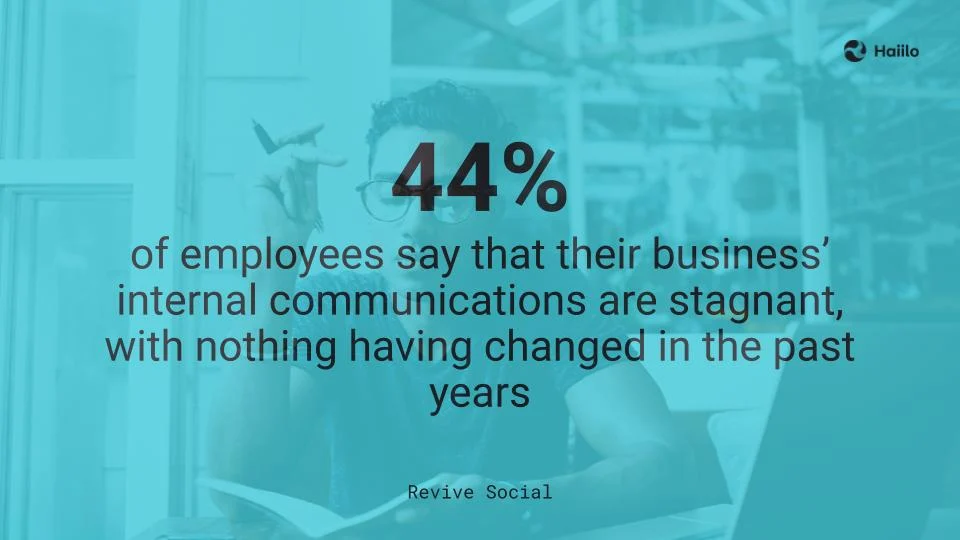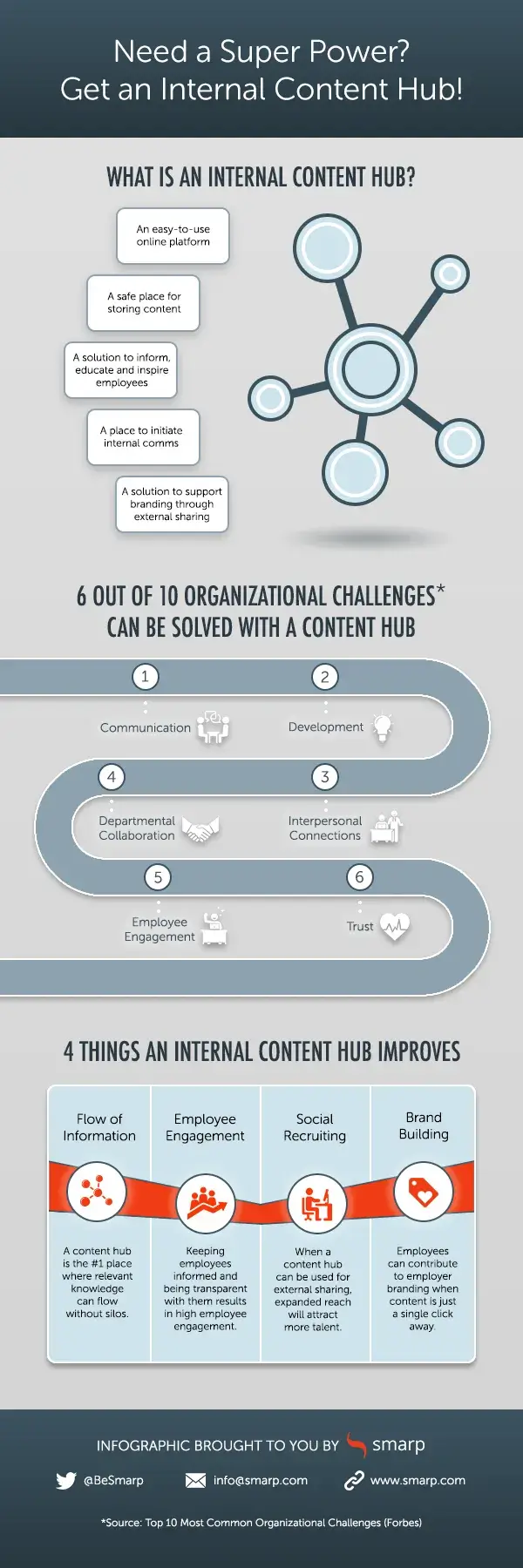How to improve communication in the workplace? We share in this blog post 5 internal communications best practices for helping employees to keep up with the company news and industry trends.
When employees are not aware of what’s happening in the company or have the feeling that they’re missing out on important information, they may feel disconnected and frustrated.
Internal Communications in the Workplace: Definition
Internal communications include all the transmissions of information between the members of an organization. In other words, internal communications are the way a company interacts with its people.

When it comes to internal communications (IC), you need to make sure they communicate your messages to your employees in an effective way. Internal communications or IC include horizontal and vertical communications.
Read more: Who is Responsible for Internal Communication?
Without a great internal communication strategy in place, your employees can easily end up wasting approximately 30% of their working time searching for the information they need, costing your company around $15,350 per worker, per year.
On the flip side, good communication is vital for high employee engagement, which makes companies 22% more profitable.
Internal communications are key to shaping an engaged and informed workforce. But your strategy will only be effective if your employees actually adopt the internal communication solutions you’ve identified as the most useful for your organization.
We’ve compiled in this blog post five internal communications best practices that can help ease the adoption process and encourage employees to engage with the content they receive.
Internal Communications Best Practices
When it comes to internal communications best practices, there is no a golden rule that fits all the organizations. Every organization is unique, and some best practices have changed significantly since the introduction of remote and hybrid work. For some employees, communication and collaboration are the biggest struggles when it comes to remote work arrangements.

Also, not every organization faces the same internal communications challenges.
However, we are delivering to you some of the must-follow best practices every internal communications professional should follow.
Best Practice #1: Build a Solid Internal Communication Plan
Remember that your internal communication channel is just the means to an end. Simply setting it up won’t instantly improve people’s ability to feel invested in your company’s objectives, and unless people actually use it, team members won’t have an easier time accessing all the information and resources they need to deliver superior work.
You’ll need to approach your internal communication the same way you approach any other aspect of your business – strategically.
Related: 4 Ways to Use Internal Communication to Kickstart Innovation in Your Company
First, you’ll need to set specific goals and decide what messages you want to share with your employees and how often you’re going to share information with them.
Meeting with your key stakeholders will help you figure out what content they need for their teams, so you can share materials that are relevant to your employees. That way you encourage your employees to stay in the habit of keeping tabs on the latest.
Building a solid and clear internal communication plan also helps make sure that you don’t overlook a particular group of employees who might otherwise feel disconnected from your organization.
We summarize in the infographic below how an internal communication solution such as an internal content hub can help you:
- Improve employee communication
- Increase employee engagement
- Boost your social recruiting strategy
- Increase your brand awareness & build a strong employer brand

Still don’t have an internal content hub, yet?
Check out Haiilo to create your easy-to-use content hub today
Best Practice #2: Segment Your Content
Many internal communication tools segment content according to its orientation – whether it’s meant to be shared internally or externally.
However, this approach is far too vague. Instead, you may want to categorize your content based on your employees’ roles in the organization and the topics they are interested in so that you don’t overwhelm them with irrelevant information.
Related: Why Your Employees Are Missing Out on Important Information
If you don’t take into account your employees’ roles, interests, or the language(s) they want to read your content in, they may keep receiving notifications for content that’s not relevant to them.
When your employees are continually interrupted by pings and alerts, productivity plummets. Frustrated with the flood of irrelevant information, they’ll quickly stop engaging with the content you share with them.
This decreases employee engagement and may lower employee productivity!

The optimal approach is to segment content across multiple channels, one for each topic you want your employees to be informed about.
Each employee can choose which channels they want to subscribe to, giving them control over the flow of information they receive in their news feed.
Related: Tom Haak on How to Improve Internal Communications in the Workplace
When employees know that they only receive relevant and interesting information, it increases their trust that time spent engaging with the content you share with them will be time well spent.
When you segment your content by topic, you can also create a mandatory channel for key company-wide content.
As long as you don’t abuse it, your employees will know that this channel is never to be ignored.
Best Practice #3: Encourage Employee Input
Your employees should be able to use your internal communication channel to share updates, provide feedback, collaborate with teammates, and forge stronger team bonds across the organization.
This is especially important for remote workers who are otherwise likely to feel isolated from the corporate culture, but it’s also true for larger organizations with branch offices all around the world.

To help your employees adapt your internal communication channel, make sure it’s a safe space where there’s no backlash against ideas or complaints.
Invite employees to create posts where they can share key learnings and best practices with their teammates.
Related: How Employee-Generated Content Can Enhance Your Content Marketing Strategy
You can also use your communication channel as a resource center where your employees can find informative and educational materials on the latest industry trends.
Segmenting content by topic also makes it easier for employees to connect with each other through their shared interests and build relationships in smaller groups.
Best Practice #4: Acknowledge Your Employees’ Efforts and Make Internal Communications Fun!
Feeling appreciated is important to everybody, and your employees are no exception.
Your internal communication channel is the perfect medium to publicly recognize your employees’ hard work and create a positive company culture.
Related: Building a Company Culture that Drives Employee Engagement
It creates a positive association with the channel and encourages employees to feel personally invested in your business success.
What’s more, if you turn your internal communication channel into a space for fun by using contests, polls, or surveys, your employees will want to keep returning to it and joining new conversations.
Don’t forget to use engaging media formats like videos, interactive newsletters, and infographics to make sure that your updates don’t become boring.

Varied formats keep your employees engaged, especially if the subject matter is complex or dense.
Some 35% of millennials say that they only engage with content that has a strong narrative, so stick to a storytelling style when you create content you’re going to share with your employees!
Related: Sara McGuire on Why Visual Storytelling Drives Higher Engagement
Best Practice #5: Measure the Effectiveness of Your Internal Communication
Without tracking the effectiveness of your internal communication strategy, you won’t be able to know what works well and what needs to be improved to increase user adoption across the organization.
First, you’ll need to set KPIs. Make sure that the metrics you decide to track allow you to know what topics your employees are interested in, identify what type of content employees read the most, and measure user engagement.
For example, you can track:
- Behavioral metrics: How many employees view each post? Which ones get the most views? What is the average time per visit?
- Attitudinal metrics: Do employees interact with the content you share with them? Do they share any feedback with you?
- Technical metrics: Does your content load quickly, is it up-to-date?
Once you have set your KPIs, make sure that you review them on a monthly or quarterly basis to keep your data accurate!
📹Watch our online session about what Internal Communications should be measuring.
Related: Top 5 Communication Skills and How to Improve Them
10 Interesting Facts About Internal Communications Best Practices
Internal communications play a very important role in driving employee engagement and company success. Hence, following the best practices is crucial.
Take a look at some statistics to learn about the power of internal communications and how to improve it.
- 60% of companies don’t have a long-term strategy for their internal communications. (Workforce)
- 74% of employees feel they are missing out on company information and news. (Trade Press Services)
- 72% of employees don’t have a full understanding of the company’s strategy. (IBM)
- 86% of employees and executives cite lack of collaboration or ineffective communication for workplace failures. (Salesforce)
- 33% of employees said a lack of open, honest communication has the most negative impact on employee morale. (Recruiter)
- More than 80% of Americans say employee communication is key to developing trust with their employers. (Lexicon)
- Businesses with effective communication are 50% more likely to have lower employee turnover. (Clear Company)
- 60% of companies have no long term strategy in place for their internal communications. (PR News)
- 44% of employees want a wider adoption of internal communication tools.
- When it comes to the pandemic more than 90% of employees said they wanted weekly communication from their company. (HBR)
Your Guide For Internal Communications
To make sure that your employees engage with the content you share with them, you’ll need to define a clear internal communication plan, build a great content strategy, and have the right tools in place.
When it comes to internal communications, there’s always room for improvement so don’t forget to set clear and measurable KPIs! That way you can review them on a regular basis and figure out how you can improve your internal communication.









